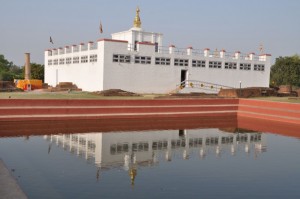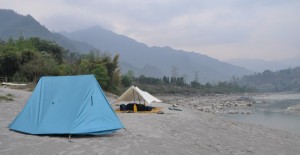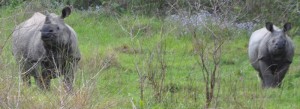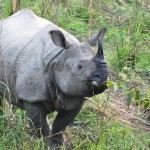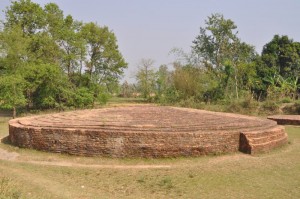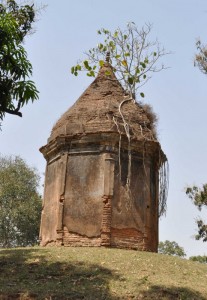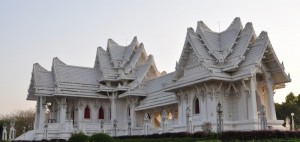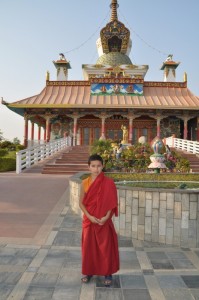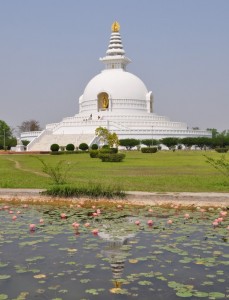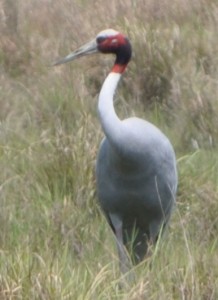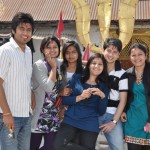Chitwan National Park & Lumbini (9 Days: March 26 – April 3)
Trekking is wonderful for both the mind and the body. Nepal a paradise for trekkers – affordable, wonderful sherpas and supports and above all, fantastic routes suitable for all levels of ability. On my third visit to Nepal, I spent 51 days in this mountain kingdom before going overland to Tibet. During my stay, I visited the Chitwan National Park and Lumbini, joined a group trek to Mustang (April 4-18) and another trek to the base camp of Kanchenjunga (the world’s third highest mountain (8586m) from April 22 to May 12.
My first visit to Nepal was in 1978 as part of my study tour. I spent one month in Nepal last November and had two wonderful treks. My original plan was to take a classic 20-day Annapurna circuit trek on my own with a porter-cum-guide. Upon arrival in Kathmandu on April 26, I found a trekking company in Thamel which offered me a good deal for two back-to-back trekking trips ie a 14-day trek to Mustang departing on April 4 and another to Kanchenjunga, departing on April 22. Before joining the Mustang trek, I went rafting on the Trisuli River, visited the Chitwan National Park and Lumbini, birth place of Lord Buddha (both are World Heritage Sites).
March 26-27 – Thamel, Kathmandu
I stayed in Thamel this time and wandered around on arrival. There are hundreds of tour companies and I found the Himalayas Trailfinder Trekking company, a family-run company, by chance. I discussed my expectations as well as limitations ie knee problem. Bassanta and his sister, Janeta are nice and understand the needs of their customers well and suggested me to join two trekking trips with fixed date departure which would be more affordable. to Mustang from April 4 to 18 and to the north base camp of Kanchenjunga starting April 22. Taking into account their professional advice, my own interest in nature and culture, my appetite for new experiences, I worked out my full itinerary for 50 days on March 27 ie rafting with overnight camping (March 28-29), a visit to the Chitwan National Park (March 29-April 1) and Lumbini ( April 1-2), the Mustang trek (April 4 – 18) and a Kanchenjunga trek (April 22 – May 8) which was subsequently extended to May 12.
March 28 -29 – Rafting and camping by the Trisuli River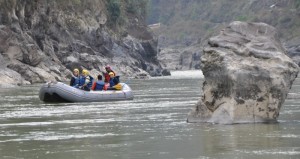
Nepal is a great place for rafting – for beginners as well as for the professionals. Rafting on the Trisuli River is available year round. The river flows through the Chitwan National Park. My original plan was to take a 2-day rafting trip starting at Charaudi which is 72km from Kathmandu with a drop-off close to the Park.
The rafting trip was fun. I met Ashoka who steered the raft and six participants (a Dutch couple and a Nepali family of four – a brother, his two sisters and a brother-in-law). We set off smoothly after a 20-minute briefing. With life-jacket on and a paddle in hand, we were all ready for action. It was cloudy and a bit windy. Ashoka tried to get us into the water. I do not like cold water and refused to jump into the water. We passed through dozens of rapids safely though the Nepali man was thrown off once without mishap. This section of the river is for beginners and not as exciting as I have imagined. We all got off around 3pm at Kuringhat, some 16km from Charandi.
As I was the only person signing up for a 2-day rafting trip, Ashoka suggested returning to Charandi (his village) for camping. I could then repeat rafting on the same section of the river the following day with another group. I always want to try something new and have no desire to repeat the same thing unless it is something extraordinary. As my Chitwan trip would not start till March 29, I need to find somewhere to spend a night. Ashoka kindly offered to set up a tent by the river for me free of charge. After spending the first two nights in the noisy Thamel, I looked for a change. Camping by the river turned out well: I enjoyed listening to the sound of the fast running water and wind. had a daal baht with buffalo meat in a shad in Ashoka’s village. His friends and villagers looked at me with amazement.
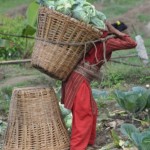 I had a wonderful sleep. The sand is soft without sandflies and mosquitoes. Ashoka and his three friends slept in an open tent nearby. Ashoka comes from Kathmandu and stays in Charaudiby because of his job. He and his friends have rented a tiny room without windows. I can fully understand why they prefer to sleep in a tent under the start!
I had a wonderful sleep. The sand is soft without sandflies and mosquitoes. Ashoka and his three friends slept in an open tent nearby. Ashoka comes from Kathmandu and stays in Charaudiby because of his job. He and his friends have rented a tiny room without windows. I can fully understand why they prefer to sleep in a tent under the start!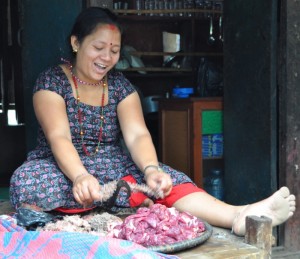
I got up just in time to watch sunrise and wandered around to watch villagers working in the fields, men fishing by the river bank and milk-men carrying milk containers on their heads. I was amazed to see two women carrying a huge basket filled with cabbages (50-70 kg) from the fields on their head. They had to walk up a steep slope to bring the cabbages to the collection point by the highway. I enjoy spending time with the local people who look happy. I discover that the Nepalis have a different way in holding their knife for meat cutting: they use their foot to hold a knife with the blade in an upright position and cut the meat by moving it up and down the blade!
March 29 – April 1 : Chitwan National Park
The Prithvi Highway from Charaudi to Bharatpur runs parallel to the Trisuli River and is scenic. The 90-minute ride is pleasant. I stopped for lunch in Bharatpur before taking a 30-minute bus ride and a short boat ride to reach the Island Jungle Resort located on the Bandarjhola Island inside the western section of the Park. I had a rustic cottage where I spent three peaceful nights in the jungle.
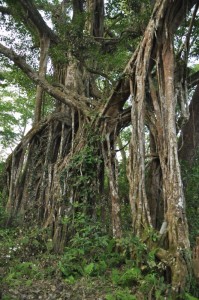 |
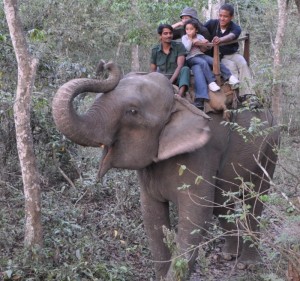 |
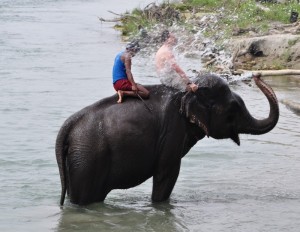 |
The Chitwan National Park is less than 200km from Kathmandu and has been a big draw for visitors. It has a total area of 932 square kilometres and is surrounded by over 750 square kilometres of community forests. It is home for leopards, some 100 Bengal tigers, the endangered one-horn rhinoceros which can also be found in Sikkim, two species of crocodiles (ie Gharial and the Marsh Muggar), deers, sloth bears, 450 species of birds and numerous types of fauna.
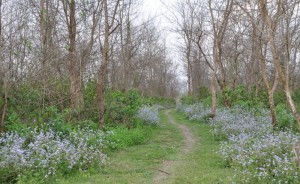 |
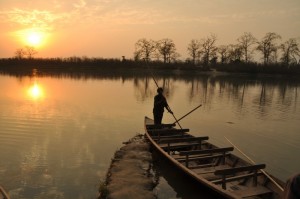 |
The Island Jungle Resort with some 40 staff and rangers is the only one on the island. Whilst most visitors take a 2 nights/3 days package, I took an extended programme with one extra day. There are many activities available : I had three elephant safaris (a late afternoon ride on the first day, a sunrise ride at 6:15am on the second day and a morning ride on the third day), three bird watching and jungle walks, a boat ride and a visit to the Tharu village.
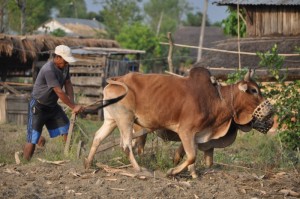 |
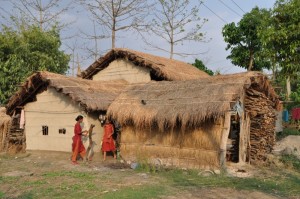 |
Life in the resort is simple but wonderful. The resort is powered by solar energy and lights are off around 9pm. Visitors therefore go to bed early as they have to get up at 5:30am for an elephant safari or jungle walk. The Park is tranquil and peaceful and the air at dusk is moist filled with scents of the forests. Though I did not see anything spectacular ie no tiger nor leopard, I had a great time and thoroughly enjoyed myself.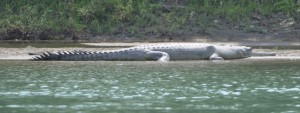
First, I saw 11 one-horn rhinoceros and a Gharial crocodile.
Second, there is no noise except those from the birds, wind and other animals. Boats crossing the river have to use oars instead of engines. I particular enjoy sitting in the bar by the river watching the mist and sunrise in the early morning and later the sunset with a cold beer.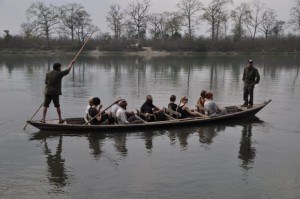
Third, I was treated like a queen on the third day. As I was the only guest on a 4-day programme, all guests arriving on March 29 had gone. I therefore had an elephant ride on a comfortable red cushion in the morning all by myself. Accompanied by a ranger, I crossed the river in the afternoon and walked for a few kilometres to a Tharus village. The villagers are said to be of Indian origin and they settled in this part of Nepal a long time ago. The mud huts are nice and tidy. Spring time is a busy season for farmers who plough and prepare the ground for cultivation. I stopped by a house and asked the owner’s permission for taking a look at the kitchen which is located in a separate mud hut outside the house. I was surprised to see how spotlessly clean it was. I visited a tiny museum which has a few artefacts on display. I did not do much but was glad to have a chance to walk around and see their village life.
April 2-3 : Lumbini
I left the Chitwan National Park around 8:30am and travelled by local bus to Lumbini, the birth place of Lord Buddha and one of the most important pilgrimage sites. Situated in the foothills of the Siwalik range in the district of Rupandehi, Lumbini is 327km from Kathmandu, 175km from Pokhara and 25km from Sunauli (Nepal-India border).
The journey is not long and the road is surprisingly good with light traffic. But I had to change three times and the small bus with 20 seats was smelly and over-crowded with over 40 passengers. The last stretch of 22km from Bhairahawa to Lumbini was a torture as the sun was scotching hot. I was too exhausted after spending over six hours on the road and was desperate to put down my bag to start sight-seeing! I decided to stay in a guest house which has a large garden though the rooms are run-down with mosquitoes. The hotel owner assured me that there would be an electric anti-mosquito coil and mosquitoes should not be a problem. (As there was no electricity in the evening, the electric coil did not work. I was badly bitten and could not sleep at all!)
I respect all religions and have studied in a Buddist secondary school for two years and received some very basic teaching of Buddhism as part of the curriculum. I remain interested in its philosophy and teaching. I am delighted to have a chance to pay homage to Lord Buddha at the Sacred Garden.
Sacred Garden
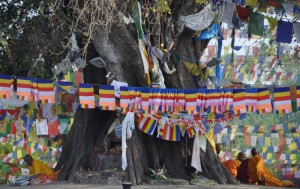 Buddhist literature mentions that Maya Devi, queen of Sakya king Suddhodana of Kapilavastu, was on the way to her maternal hometown Devadaha (ancient Koliya kingdom), was passing through the Lumbini Garden and took a bath in the Puskarini. After her bath, she proceeded to the north 25 paces when she felt labour pain. She supported herself grasping a branch of a tree and gave birth to Siddhartha on the full month day of the first month of Nepali calendar in 623 BC.
Buddhist literature mentions that Maya Devi, queen of Sakya king Suddhodana of Kapilavastu, was on the way to her maternal hometown Devadaha (ancient Koliya kingdom), was passing through the Lumbini Garden and took a bath in the Puskarini. After her bath, she proceeded to the north 25 paces when she felt labour pain. She supported herself grasping a branch of a tree and gave birth to Siddhartha on the full month day of the first month of Nepali calendar in 623 BC.
The Mauraya Emperor Asoka made a pilgrimage to this holy site in 249 BC and erected a stone pillar bearing an inscription stating ‘Hida Buddhe Jate Sakyamuniti’ (here Sakyamuni Buddha was born).The sacred site went slowly to oblivion. In 1896 the Governor of Palpa, General Khadga Shumsher and Dr Alois Fuhrer, an emminent archaeological surveyor in British India, discovered the Asoka pillar drawing the attention of historians and archaelogists. In 1899, PC Mukherji found the Nativity Sculpture and some structural remains in and around the birthplace. In the 1930s, General Keshar Shumsher began to carry out large-scale excavation. In 1990s, the Maya Devi complex was excavated. Conservation and excavation and of the holy complex now rests with the Lumbini Development Trust formed since 1985.
The Maya Devi Temple is the heart of the holy site where there are several layers of construction over the centuries. The ground floor consists of remains of the foundations of the early Maya Devi Temple which dates back to 3rd century BC. The sanctum sanctorum with the Marker Stone is the birth spot of Buddha. The Stone was discovered after excavation of the old Maya Devi Temple in 1996. The main object of worship is the Nativity Sculpture depicting the nativity scene in the Mathura style (from 4th or 5th century AD) was installed by Malle kings of the Naga Dynasty from about 11th to 15th century. Maya Devi is holding a branch of a tree with her right hand for support in the time of her delivery with her sister, Gautami Prajapati next to her. The newly born prince Siddhartha is standing upright on a lotus pedestal with two celestial figures receiving him.
The two main monuments in the Sacred Garden just outside the temple are the Ashoka Pillar and the Puskarini, the Holy Pond in the Sacred Garden. The Pillar erected in 249 BC bears the first epigraphic evidence with reference to the birthplace of Buddha. The text was written in Brahmi script and Pali language. The Pusharini is where Maya Devi bathed just before giving birth and the newly born prince is believed to have taken his first purification bath. Owing to ongoing construction works, photo-taking and talks inside the Maya Devi Temple, I did not find the peace and serenity I had been looking for at this holy site.
 |
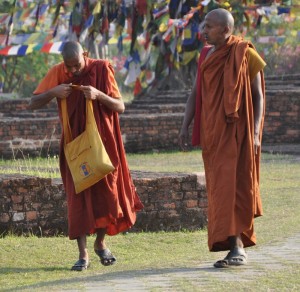 |
On the following day, I went on a pilgrimage trail around Lumbini sharing a taxi with Sam, a pilgrim and retired engineer from Malaysia and Dominique, a Belgian lady. They also stayed at the same hotel.
Tilaurakat, the ancient capital of Sakya kingdom (Kapilavastu) is located about 24km west of Lumbini. Siddhartha lived in the palace for 29 years as a prince, got married and had a son before renunication. Ramparts of a moat and a fortication wall with its western and eastern gates surround the remains of the citadel including some ancient structural remains in the central part of the mound. The foundation of two big stupas are in good condition in a nearby village. Our visit was however disturbed by a group of local children who followed us around begging for money.
Kudan, the ancient Nyagrodharnama, is the site where Buddha stayed with 300 disciples preaching five important sutras and told the story of his search for supreme knowledge. King Suddhodana met the Buddha the first time after his renunciation and Yasodhara, his wife invited him for a meal in the palace. Rahula, his son, at the age of 8 was ordained by Sariputra, his most revered disciple. I find the monument in Kudan better preserved than those in Tilaurakat. I found this site more atmospheric as there was a large group of pilgrims (around 100) from Cambodia all dressed in white sitting under a couple of big trees listening to the preaching of a monk.
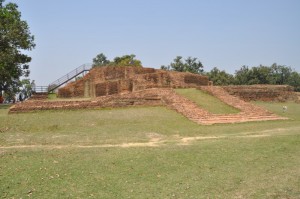 |
The normal pilgrimage route covers other sites including Niglihawa and Gothihawa, the birthplace of Kanakmuni, the second Buddha of Bhadrakalpa and Krakuchhanda Buddha respectively. Both have a pillar erected by king Ashoka in 249 BC. But the taxi driver who cannot speak English, refused to go on the excuse that the road was bad. On the way back to the hotel, we pressed the taxi driver to take us to see the World Peace Pagoda of Japan and the crane sanctuary where we saw a couple of sarus cranes, the world’s tallest flying bird and one of the most endangered.
In the afternoon, Sam, Dominique and I cycled to the monastic zones where 41 plots have been set aside for temples and monasteries representing each of Buddhism’s major sects and national styles of worship. In addition, there is a Cultural Centre comprising a research centre, a library, and a museum. As it was very hot in midday, we did not set off till 2pm and could only visit the Chinese Monastery (China), Geden International (Austria), the Great Lotus Stupa (Germany) and the Royal Thai Monastery (Thailand). The architecture and garden of the last two monasteries are distinctive and beautiful.
I left Lumbini without a peaceful mind and a sense of fulfilment which I normally experience after visiting a holy site. For me, a holy site should have an atmosphere of spirituality, peace and serenity. Atmosphere in both the Sacred Garden and the monastic zones is not as tranquil and peaceful as I have expected – the construction noises are disturbing. Second, the behaviour of some of the tourists/pilgrims inside the Maya Devi Temple is disgusting. Visitors are advised to keep silent and not to take photos. But some visitors ignored the advice and no action was taken by the authority. Third, my attempt to visit other pilgrimage sites near Lumbini was frustrated by an uncooperative taxi driver and I was disturbed by the boys in Tilaurakot.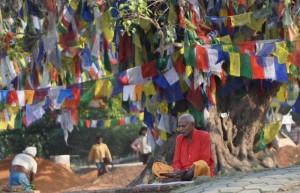
In order to promote understanding of Buddhism and the teaching of Buddha, the relevant Buddhist bodies can help promoting the religion by arranging a guided circuit to important pilgrimage sites around Lumbini. The roads to these sites are very bad and the local/national government should make an effort to improve the infrastructure if Nepal is serious in making Lumbini an international pilgrimage and tourist centre.
There is so much to see both in and outside Lumbini. I like to return one day to spend a week or two in one of the monasteries to learn more about Buddhism. I hope to find a peaceful, spiritual and tranquil holy Lumbini one day.
April 3 : Pokhara
I was in Pokhara last November and completed a 5-day trek to Poon Hill. This time, I had to meet up with the trekking group which would arrive in Pokhara from Kathmandu on April 4. As there is no direct tourist bus between Pokhara and Lumbini, the 180km-journey by local bus takes a whole day. One has to take a bus to Bhairahawa and to get another long-distance bus to Pokhara.
Luck was on my side: I met a group of 24 students from the Tribhuwan University, who stayed in the same hotel and would have their own bus to go to Pokhara. They kindly allowed me to take a ride thus saving me a lot of trouble.
At 7:30am on April 3, I set off with the students. The scenery along the Siddhartha Highway is stunning with countless twists and turns, beautiful mountains and green valleys. We arrived at Tansen at 10:15am. As I was not too sure about the exact departure time, I dared not wander off too far from the bus park and only made my way to the 19th century Amar Narayan Mandir, a pagoda-style temple that is a stopping place for sadhus on their way to Jania Purnima festivities at Muktinath in late July or early August. But I missed out on the Durbar Square. The area is famous for its dhaka weavers and many shops sell souvenirs including dhaka topi, the “Nepali cap” and thailo, purse made from dhaka. I bought a purse as a souvenir.
Tansen has a commanding view of the valleys, terraced fields and villages and there are many colourful buildings perched at the hill tops. I brought juice and chips for the students to thank them for giving me a lift. In return, the staff accompanying the students on this trip invited me to join them for a daal baht lunch in a local restaurant. After lunch, we had a brief stop at a Hindu temple and finally arrived in Pokhara around 7pm. The young people are jolly, chatting, singing and dancing in the bus. As they did not speak much English, I could not take this golden opportunity to find out more about views on their countries and aspirations. (End of Part 1)


